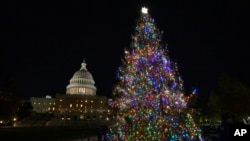One special tree will be making its way from deep in the forests of Alaska to the heart of the nation's capital just in time for the holiday season.
"It's an honor to have the 2024 U.S. Capitol tree come from Alaska," Alaska Governor Mike Dunleavy said.
In 1964, John McCormack, then the speaker of the U.S. House of Representatives, placed a Christmas tree on the Capitol lawn. Thus, the tradition of the Capitol Christmas tree, or "The People's Tree," was born.
The U.S. Forest Service began providing the tree in 1970, at the request of the Capitol Architect. Since then, a different national forest has delivered the tree each year.
"The Forest Service rotates the responsibility, or really the privilege, of harvesting the Capitol Christmas tree amongst all of its regions, and within each region, they will select which forest it comes from for that given year," Brandon Raile, a public affairs officer for the Forest Service, told VOA.
This year, the tree will come from the Tongass National Forest, the country’s largest national forest. The only other time a Capitol Christmas tree has come from Alaska was in 2015, when a nearly 23-meter-tall Lutz spruce was selected from the Chugach National Forest,
The tree selection process can be involved.
Tom Roland, who works for the Chugach National Forest as a silviculturist — someone who controls the growth and health of a forest, said a team searches for a full, conically shaped tree that’s 18 to 24 meters tall. He said between eight and 12 trees are offered to the Capitol Architect, who makes the final decision.
"One of the things that makes this year's U.S. Capitol Christmas tree so unique is that it's coming from Alaska. The two national forests in Alaska cover about 21.9 million acres. To cover that kind of ground and work through the process of the selection here is really exceptionally challenging," Roland told VOA.
Once cut, the tree begins its long trek from Alaska to Washington.
"Keeping a tree healthy during a journey like this is really hard," Roland said.
While traveling, the tree is kept at a stable temperature, shielded from the wind and kept moist through a hydration system.
On its way to the Capitol, the Alaska tree will travel on an expandable trailer, two different barges, and a truck.
The tree also is part of a "whistle stop" tour; it will make brief stops in communities across the country so the public can see the tree.
When the tree is finally displayed at the Capitol, it will be adorned with thousands of ornaments that Alaskans made by hand.
Roland said this year's tree selection would be finalized around July 19 and harvested sometime in October. The tree species will be announced later.
